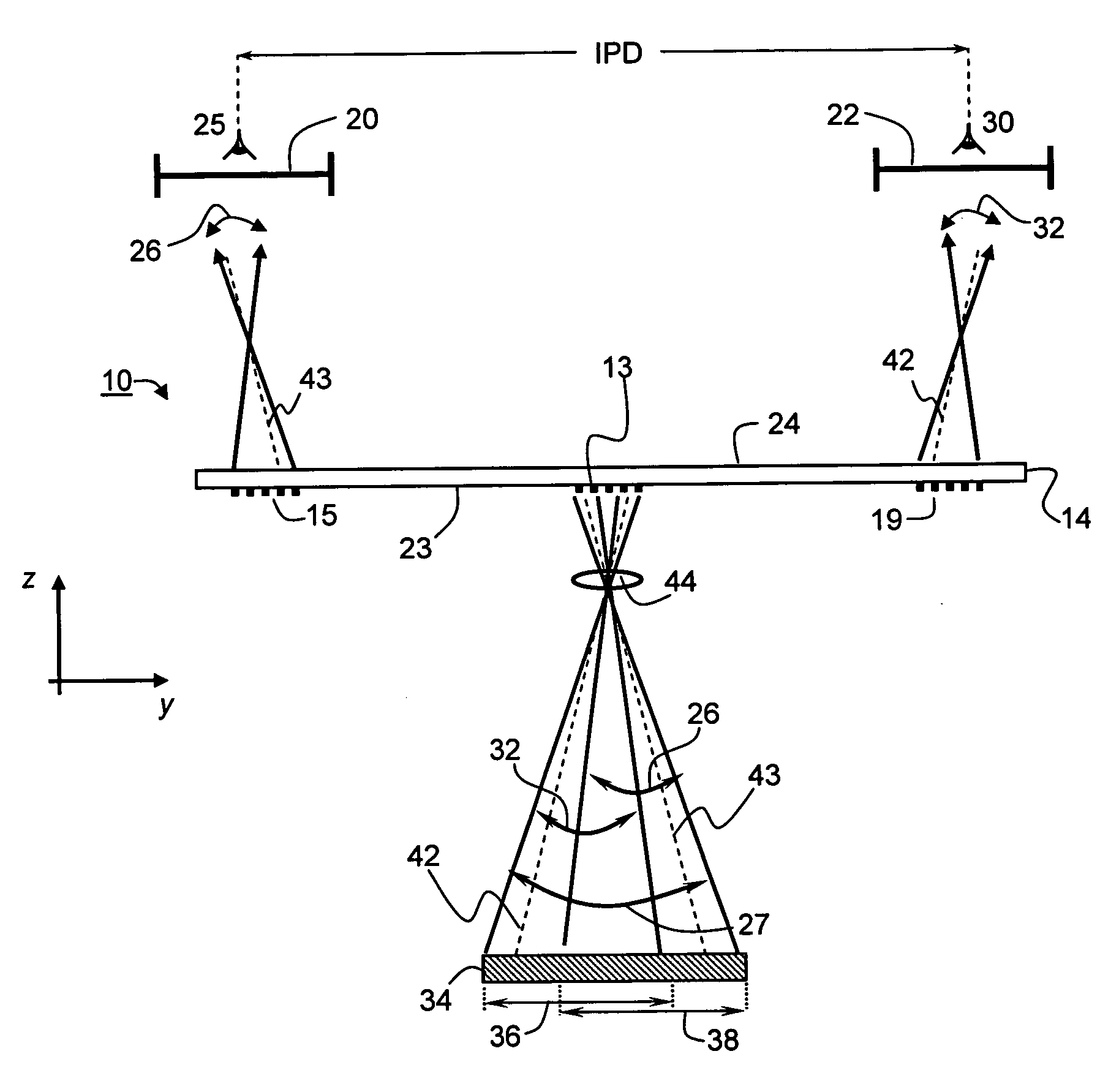Diffractive Optical Device and System
a technology of optical systems and optical devices, applied in the field of optical systems, can solve the problems of not being able to easily miniaturize, heavy crt displays, and inability to view sharp images at a closer distance, and achieve the effect of reducing the cost of operation, and increasing the cost of operation
- Summary
- Abstract
- Description
- Claims
- Application Information
AI Technical Summary
Benefits of technology
Problems solved by technology
Method used
Image
Examples
example 1
[0223]Following is a non-limiting example in which planar dimension calculations are performed in accordance with the teachings of the preferred embodiments of the invention for the diffraction of red light.
[0224]The present calculations are for 509 nm period gratings formed in a light transmissive substrate having index of refraction of 1.522 and thickness of 2 mm. As a representative example for red light, a wavelength of 615 nm was assumed.
[0225]With the above values of the grating period, index of refraction and wavelength a longitudinal field-of-view Ωy of [−12.0°, +12.0°] and a transverse field-of-view Ωx of [−9.0°, +9.0°] can be achieved. The overall (diagonal) field-of-view Ω is calculated using Equation 5 to obtain Ω=[−15°, +15°].
[0226]For Δz=25 mm, the minimal dimensions of the output optical element(s) are (see Equation 6) LO, min=10.6 mm and WO, min=7.9 mm. For LEB=4 mm, WEB=1 mm and Op=3 mm, the dimensions of the output optical element(s) are (se...
example 2
[0230]Following is a non-limiting example in which planar dimension calculations are performed in accordance with the teachings of the preferred embodiments of the invention for the diffraction of blue light.
[0231]The present calculations are for 389 nm period gratings formed in a light transmissive substrate having index of refraction of 1.529 and thickness of 1.8 mm. As a representative example for blue light, a wavelength of 465 nm was assumed.
[0232]With the above values of the grating period, index of refraction and wavelength a longitudinal field-of-view Ωy of [−11°, +11°] and a transverse field-of-view Ωx of [−8.3°, +8.3°] can be achieved. The overall (diagonal) field-of-view Ω is calculated using Equation 5 to obtain Ω=[13.7°, +13.7°].
[0233]For Δz=20 mm, the minimal dimensions of the output optical element(s) are LO, min=7.8 mm and WO, min=5.8 mm. For LEB=5 mm, WEB=2 mm and Op=3 mm the dimensions of the output optical element(s) are LO=15.8 mm and WO=...
example 3
Non-Uniform Duty cycle
[0237]FIGS. 11a-d show numerical calculations of the diffraction efficiency of a grating as a function of the duty cycle, for impinging angles φiy of 50° (FIGS. 11a-b) and 55° (FIGS. 11c-d), and modulation depths 6 of 150 nm (FIGS. 11a and 11c) and 300 nm (FIGS. 11b and 11d). The different curves in FIGS. 11a-d correspond to wavelengths of 480 nm (solid line), 540 nm (dashed line) and 600 nm (dot-dash line). The calculations were based on the Maxwell equations, for 455 nm period grating formed in a light transmissive substrate having index of refraction of 1.53.
PUM
 Login to View More
Login to View More Abstract
Description
Claims
Application Information
 Login to View More
Login to View More - R&D
- Intellectual Property
- Life Sciences
- Materials
- Tech Scout
- Unparalleled Data Quality
- Higher Quality Content
- 60% Fewer Hallucinations
Browse by: Latest US Patents, China's latest patents, Technical Efficacy Thesaurus, Application Domain, Technology Topic, Popular Technical Reports.
© 2025 PatSnap. All rights reserved.Legal|Privacy policy|Modern Slavery Act Transparency Statement|Sitemap|About US| Contact US: help@patsnap.com



